Gentiana andrewsii, bottle gentian, is an native perennial herbaceous plant. It has unusual flowers that look like flower buds but are in full bloom. They are an attractive blue and bloom in the fall. Characteristics that distinguish G. andrewsii from its look-alike, G. clausa, are presented.
Flowers
Inflorescence/Flower cluster:
 Gentiana andrewsii flower clusters develop at the top a stem immediately above a whorl of 2 pairs of leaves. Some times smaller clusters of flowers may develop in the axils of the upper leaf pairs.
Gentiana andrewsii flower clusters develop at the top a stem immediately above a whorl of 2 pairs of leaves. Some times smaller clusters of flowers may develop in the axils of the upper leaf pairs.

Individual Flower:
The Gentiana andrewsii flower even at maturity resembles a large closed bud, 1 to 1.5 inches long. The flowers are different shades of blue, violet, with some white. The corolla has vertical ridges and appear wrinkled.
The flower has 5 petals with connecting tissue called plaits, folds, pleats, or floral appendages. These parts can be easily seen in a gentian flower like Pinebarren gentian (click here). Unlike Pinebarren gentian where the lobes and plaits are obvious, in G. andrewsii the lobes and plaits are fused and the corolla is closed up so that the distinctions are not obvious.
Flower lobes and plaits in G. andrewsii.
Gently pressing on the 'bottle' opens the corolla and the lobes and plaits can be observed. The lobes are blue on the outer surface and the interconnecting plaits are whitish and folded inward. It is the relative heights of the lobes and plaits that helps distinguish between the bottle-like gentian species.

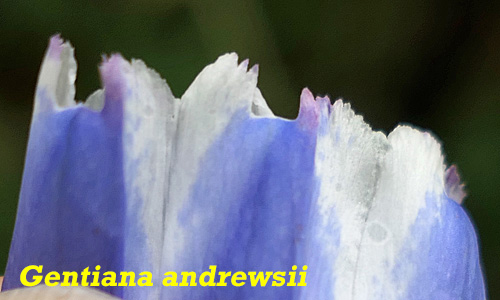
A closer look at the flower lobes and plaits in G. andrewsii..
Features of the lobes and plaits.
- The plaits are longer than the lobes.
- The plaits are fringed
- lobes truncate and often apiculate (abrupt short projected tip)
- lobes narrower than the plaits near the tips
In contrast, in G. clausa, the lobes and plaits are about the same length and the plaits have teeth but not fringes.

Since the whitish plaits are longer than the blue lobes sometimes white tips of the plaits extend beyond the blue or many times just the colored fringes of the plaits adorn the flower tops. Sometimes the plant is called fringe-top bottle gentian.
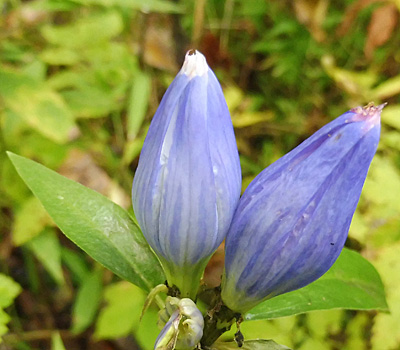
Sepals/CalyxThere are 5 sepals but they are fused into a half inch long tube that separates into 5 small lance-shaped lobes. At the base of the flower beneath the sepals is a pair of bracts and a pair of leaves.
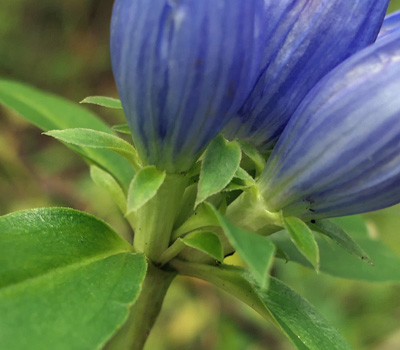
Inside:There are 5 stamens and a pistil with a stigma that divides in 2. There are nectaries at the base.
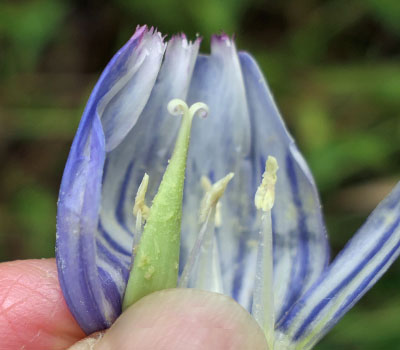
The flower exhibits protandry: the stamens mature before the pistil
1a: anthers mature 1b: stigma mature.
The flower is also herkogamous: in this case the height of the stigma and anthers are different to discourage self-pollination. Hand-pollination studies showed that it is self-fertile (Costelloe 1988).
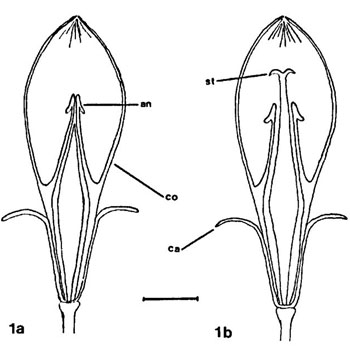
Diagram (Costelloe 1988) longitudinal section
Pollination
G. andrewsii offers both nectar and pollen as rewards to its pollinators. Much of the information here on pollination is from studies by Costelloe 1988. The research was done in Ohio. The studies showed that G. andrewsii is completely dependent on bumble bees for pollination and seed set. Bumblebees (Bombus spp.) were the only insects they observed to have the strength and learning capability necessary to open the closed corolla consistently. Interestingly, the pollen was only found on the bee's sternum (chest).
When a bee lands on the tip of a flower, it holds on with its mid and hind legs, and uses it head and front legs to open the corolla. It enters the flower head first, downward. If the stigma is mature, its sternum comes into contact with the stigma and deposits possible pollen from previous flower visits.
After the bee is completely inside, the corolla closes. Still pointing downward, the bee scrapes pollen off the anthers with its legs and the pollen falls onto its sternum. The bee needs to push further down to get the nectar at the base of the flower. The bee spends 2-10 seconds collecting pollen and nectar.
The bee backs out. In the process the sternum again comes into contact with the stigma. If the stigma is mature and the anther pollen is also mature, it can self-pollination at this time.
At the study site, about half of the bottle gentian corollas had holes at its base. Other studies reported that the holes are done by eastern carpenter bees (Xylocopa virginica). With the holes present, many other smaller bees come for the nectar while not contributing to pollination.
Since the purpose of a flower is to get pollinated and produce seeds, why would a flower hide its reproductive parts from pollinators? There is a mutualistic association: the bees have an exclusive access to the gentian pollen and nectar and the gentians have "loyal" pollinators.
Plant - Leaves - Habitat
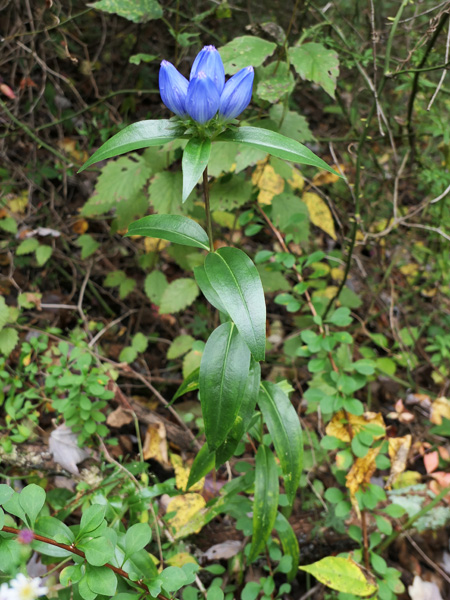 The G. andrewsii plant is a upright perennial 1-2' tall. It can have multiple stems that emerge from the taproot. These stems are unbranched.
The G. andrewsii plant is a upright perennial 1-2' tall. It can have multiple stems that emerge from the taproot. These stems are unbranched.
However, the stems are weak and frequently fall over in the shade.
The leaves are opposite and sessile. They are up to 4½" long and 2" across. They are wider at the base tapering to a point at the tip. Sometimes the leaves are broadest in the middle. The leaf upper surface is often dark green and shiny.
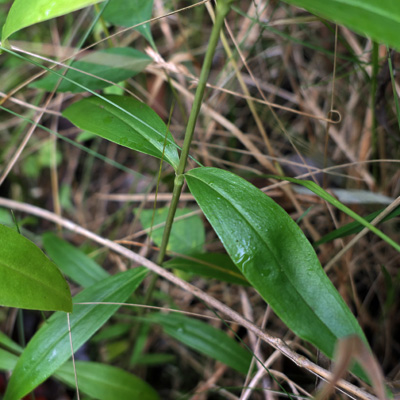
Broader leaf

The margins of the leaves are actually cilliated. They are visible with low magnification. This characteristic is sometimes mentioned when differentiating gentiana species.
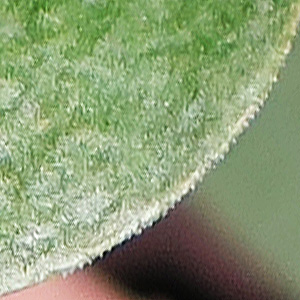
The habitat includes moist, shaded sites.
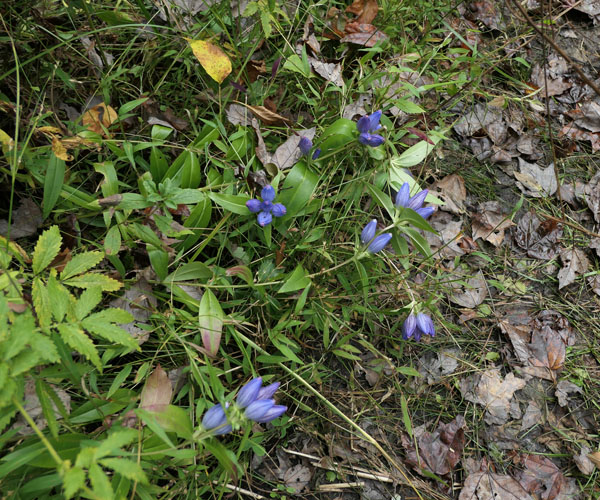
Text by Millie Ling and all photos by Hubert & Millie Ling. Photos: September, cultivation, Morris county.
Cultivation
The cultivation material below is courtesy of
Jersey Friendly Yards searchable plant database: Gentiana andrewsii
In NJ it blooms late summer until frost.
Hardiness Zone: 6a, 6b
Physiographic Region: Ridge & Valley, Piedmont, Highland
Salt Tolerance: not known
Soil Type: Loam, Organic, Sandy, Clay
Soil Moisture: Moist, Wet
Drought Tolerance: None
Soil pH: Slightly Acidic, Neutral
Optimal Light: Partial Shade
Light Range: Full Sun, Partial Shade
Growth Rate: Slow
Additional information
Additional information / references:
- Pollination Ecology of Gentiana andrewsii, Costelloe, B. 1988, https://kb.osu.edu/bitstream/handle/1811/23269/1/V088N4_132.pdf
- Flower-Visiting Insects of Bottle Gentian, http://www.illinoiswildflowers.info/flower_insects/plants/btl_gentian.htm
- The USDA website shows Gentiana andrewsii distribution in the US and other information: https://plants.sc.egov.usda.gov/home/plantProfile?symbol=GEAN
- The Explorer at NatureServe shows Gentiana andrewsii distribution and rarity in the US and other information: https://explorer.natureserve.org/Taxon/ELEMENT_GLOBAL.2.144353/Gentiana_andrewsii.
- GoBotany gives excelent comparisons of look-a-like species. https://gobotany.nativeplanttrust.org/species/gentiana/andrewsii/
- A YouTube Video of a bumblebee invading a bottle gentian https://www.youtube.com/watch?v=dYQ6A_PPmI4
- Minnesota Wildflowers: descriptions. https://www.minnesotawildflowers.info/flower/bottle-gentian
- Southwest: descriptions. https://swbiodiversity.org/seinet/taxa/index.php?taxon=47003&clid=3516